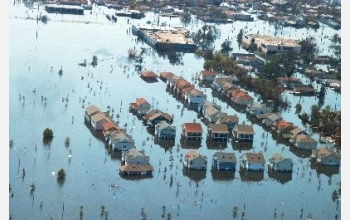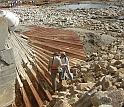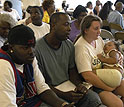News Release 06-123
Remembering Katrina
Studies look at multiple facets of the hurricane's devastation

New Orleans houses are swamped by floodwaters after Hurricane Katrina.
August 29, 2006
This material is available primarily for archival purposes. Telephone numbers or other contact information may be out of date; please see current contact information at media contacts.
In the year since Hurricane Katrina struck the coasts of Louisiana, Mississippi, Alabama and Florida, scientists and engineers have examined the full breadth of the storm's aftermath--from levee failures and ecosystem damage to weather predictions and human responses in the midst of catastrophe.
According to a FEMA report, more than 1,300 people lost their lives in Louisiana and Mississippi alone; 450,000 were displaced. Total economic losses exceeded an estimated $125 billion, including homes, universities, bridges and other infrastructure--and some 350,000 vehicles and 2,400 ships.
Some researchers arrived on the scene immediately to collect critical clues before they were lost to rescue and clean-up operations--and time. Other research took place in distant laboratories, where investigators plugged numbers into computer models or built search robots. The scientists and engineers all sought to understand exactly how the destruction happened, if and when it could happen again, and especially, how to prevent such carnage in the future.
The National Science Foundation (NSF) supported many of the studies under its Small Grants for Exploratory Research (SGER) program. Although the program was created to support small-scale, exploratory, high-risk research of all kinds, it has proved to be especially well-suited for rapid-response situations because SGER requests can be processed and approved more quickly than other research proposals. Indeed, NSF has previously used the SGER program to field research teams in the aftermaths of both the Sept. 11, 2001, terrorist attacks and the 2004 Indian Ocean tsunami.
Investigators supported under the SGER program often join other NSF-supported investigators who have been in the field for some time.
Selected projects from the past year are highlighted below.
- NSF Announces "Rapid Response" Awards to Learn the Lessons of Katrina
The National Science Foundation (NSF) announced the first of several dozen grants to send research teams into the Gulf Coast regions devastated by Hurricane Katrina. These "rapid-response" teams will seek to draw as many lessons as possible from the disaster before evidence is lost and memories can fade. - NSF Announces New Awards to Study the Impact of Katrina on People and Social Systems
Whereas the initial wave of rapid-response teams tended to focus on engineering problems--the most notable being the failure of the New Orleans' levee system--the second group of teams focused on the human side of the story, including how people and organizations responded to the disaster and which factors are shaping the reconstruction. - NSF's Response to the Hurricanes
A fact sheet about NSF information and resources. - Researchers Release Draft Final Report on New Orleans Levees
Following an 8-month study of the New Orleans levee system and its performance during Hurricane Katrina, a 30-person team of researchers led by Raymond Seed and Robert Bea of the University of California, Berkeley, released a near-complete draft of their findings on May 22, 2006, in a "town hall" meeting in that Gulf Coast city. - Hurricane Katrina: Scientists Fly Into Eye of the Storm
The Rainband and Intensity Change Experiment (RAINEX) project became the first hurricane research project to fly planes nearly simultaneously inside and outside a hurricane's principal rainband, gathering information that will help scientists to better understand changes in a hurricane's intensity. - Number of Category 4 and 5 Hurricanes Has Doubled Over the Past 35 Years
The number of Category 4 and 5 hurricanes worldwide has nearly doubled over the past 35 years, according to a study by researchers at the Georgia Institute of Technology and the National Center for Atmospheric Research. The change occurred as global sea-surface temperatures have increased over the same period. - Seeing Into the Eye of Hurricane Rita
An advanced research weather model run by the National Center for Atmospheric Research in Boulder, Colo., followed Hurricane Rita to give scientists a taste of how well forecast models of the future may predict hurricane track, intensity, and important rain and wind features. - Gulf Warm-Water Eddies Intensify Hurricane Changes
Scientists monitoring ocean heat and circulation in the Gulf of Mexico during Hurricanes Katrina and Rita have a new understanding of how these tropical storms can gain intensity so quickly: The Gulf of Mexico's "Loop Current" is likely intensifying hurricanes that pass over eddies of warm water that spin off the main current. - Small, Unmanned Aircraft Search for Survivors in Katrina Wreckage
Providing benefits of speed, portability and access, a pair of unmanned aerial vehicles surveyed storm-damaged communities in Mississippi as part of the search for trapped survivors of Hurricane Katrina. - Robotics Researchers Return to Examine Katrina Devastation With Small Unmanned Helicopters
Building upon an earlier search mission using helicopter unmanned aerial vehicles, engineering researchers from the University of South Florida returned on Nov. 28, 2005, to the Mississippi Gulf Coast with their small, radio-controlled aircraft. - Large Centrifuge Helps Researchers Mimic Effects of Katrina on Levees
Researchers studying the effects of Hurricane Katrina on the levees of New Orleans used a 150 g-ton centrifuge to model one of New Orleans' levee sections and the hurricane forces that led to the levee's failure. The goal of the test was to learn how layers of peat and clay beneath the levees might have contributed to the failure.
-NSF-
-
Scientists from the RAINEX project flew into the edge of Hurricane Katrina.
Credit and Larger Version -
Geotechnical engineers inspect a portion of the floodwall along the Industrial Canal.
Credit and Larger Version -
An unmanned aerial vehicle searches wreckage for survivors in Pearlington, Miss.
Credit and Larger Version -
Louisiana residents displaced by Hurricane Katrina seek shelter and aid in Pensacola, Fla.
Credit and Larger Version
Media Contacts
Josh Chamot, National Science Foundation, (703) 292-7730, email: jchamot@nsf.gov
Related Websites
Special Report: Disasters: http://www.nsf.gov/news/special_reports/disasters/index.jsp
Special Report: After the Tsunami: http://www.nsf.gov/news/special_reports/tsunami/index.jsp
Small Grants for Exploratory Research: Hurricane Katrina: http://www.nsf.gov/pubs/2005/nsf05053/nsf05053.jsp
Frequently Asked Questions: NSF's Response to Hurricane Katrina: http://www.nsf.gov/pubs/policydocs/katrinafaqs2.pdf
The U.S. National Science Foundation propels the nation forward by advancing fundamental research in all fields of science and engineering. NSF supports research and people by providing facilities, instruments and funding to support their ingenuity and sustain the U.S. as a global leader in research and innovation. With a fiscal year 2023 budget of $9.5 billion, NSF funds reach all 50 states through grants to nearly 2,000 colleges, universities and institutions. Each year, NSF receives more than 40,000 competitive proposals and makes about 11,000 new awards. Those awards include support for cooperative research with industry, Arctic and Antarctic research and operations, and U.S. participation in international scientific efforts.
Connect with us online
NSF website: nsf.gov
NSF News: nsf.gov/news
For News Media: nsf.gov/news/newsroom
Statistics: nsf.gov/statistics/
Awards database: nsf.gov/awardsearch/
Follow us on social
Twitter: twitter.com/NSF
Facebook: facebook.com/US.NSF
Instagram: instagram.com/nsfgov






